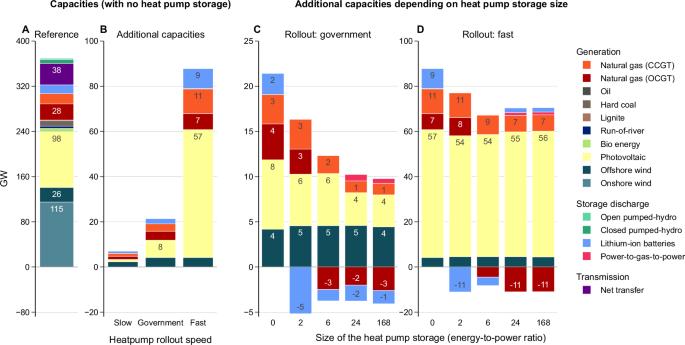Power sector benefits of flexible heat pumps in 2030 scenarios
IF 8.1
1区 地球科学
Q1 ENVIRONMENTAL SCIENCES
引用次数: 0
Abstract
Heat pumps play a major role in decreasing fossil fuel use in heating. They increase electricity demand, but could also foster the system integration of variable renewable energy sources. We analyze three scenarios for expanding decentralized heat pumps in Germany by 2030, focusing on the role of buffer heat storage. Using an open-source power sector model, we assess costs, capacity investments, and emissions effects. We find that investments in solar photovoltaics can cost-effectively accompany the roll-out of heat pumps in case wind power expansion potentials are limited. Results further show that short-duration heat storage substantially reduces the need for firm capacity and battery storage. Larger heat storage sizes do not substantially change the results. Increasing the number of heat pumps from 1.7 to 10 million units could annually save more than half of Germany’s private and commercial natural gas consumption and around half of households’ building-related CO2 emissions. Investments in solar photovoltaics could cost-effectively support the expansion of heat pumps by 2030, and small thermal storage of heat pumps could reduce the additional need for firm capacity and battery storage, according to an analysis that uses an open-source power sector model.

2030 年情景下灵活热泵的电力部门效益
热泵在减少供暖中化石燃料的使用方面发挥着重要作用。它们会增加电力需求,但也能促进可变可再生能源的系统集成。我们分析了到 2030 年在德国推广分散式热泵的三种方案,重点关注缓冲蓄热的作用。通过使用开源电力行业模型,我们对成本、产能投资和排放效应进行了评估。我们发现,在风力发电扩展潜力有限的情况下,太阳能光伏发电投资可以经济高效地配合热泵的推广。结果进一步表明,短时储热可大幅减少对稳定容量和电池储能的需求。更大规模的蓄热并不会显著改变结果。将热泵的数量从 170 万台增加到 1000 万台,每年可节省德国一半以上的私人和商业天然气消耗量,以及约一半的家庭建筑相关二氧化碳排放量。根据使用开源电力行业模型进行的分析,到 2030 年,对太阳能光伏的投资可以经济有效地支持热泵的扩展,而热泵的小型热存储可以减少对稳定容量和电池存储的额外需求。
本文章由计算机程序翻译,如有差异,请以英文原文为准。
求助全文
约1分钟内获得全文
求助全文
来源期刊

Communications Earth & Environment
Earth and Planetary Sciences-General Earth and Planetary Sciences
CiteScore
8.60
自引率
2.50%
发文量
269
审稿时长
26 weeks
期刊介绍:
Communications Earth & Environment is an open access journal from Nature Portfolio publishing high-quality research, reviews and commentary in all areas of the Earth, environmental and planetary sciences. Research papers published by the journal represent significant advances that bring new insight to a specialized area in Earth science, planetary science or environmental science.
Communications Earth & Environment has a 2-year impact factor of 7.9 (2022 Journal Citation Reports®). Articles published in the journal in 2022 were downloaded 1,412,858 times. Median time from submission to the first editorial decision is 8 days.
 求助内容:
求助内容: 应助结果提醒方式:
应助结果提醒方式:


